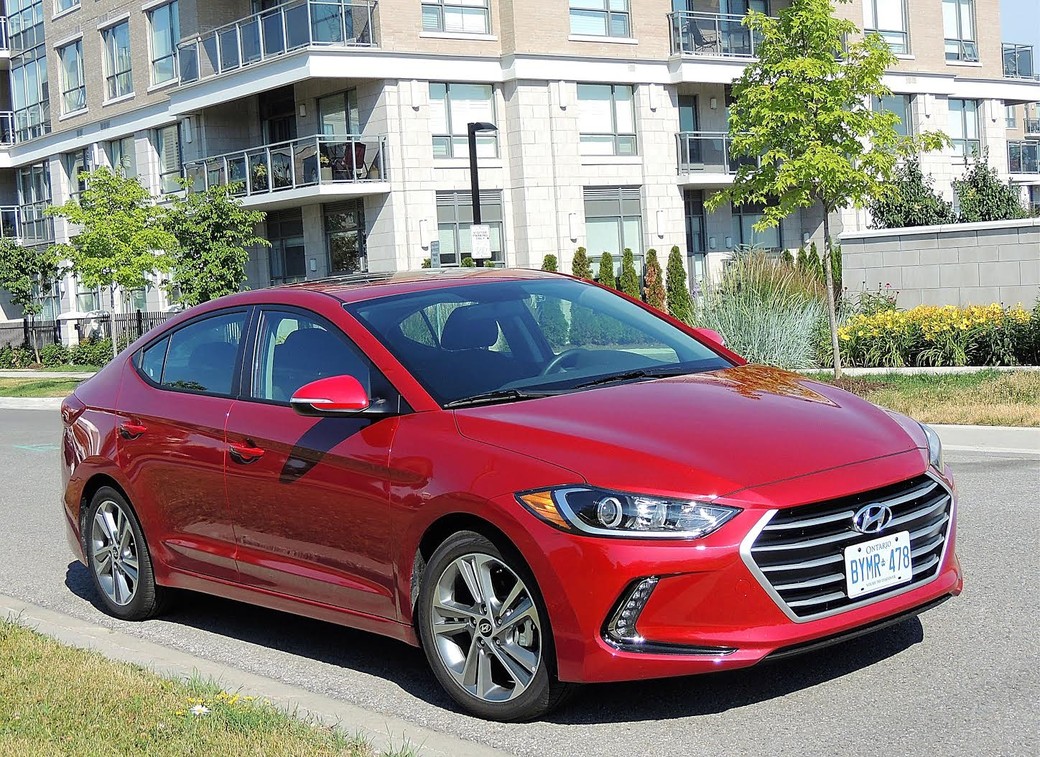
Elantra Continues to Surprise with Premium Content
All Photos by Neil Moore.
Far too often, auto scribes have pointed out how “Hyundai has raised the bar yet again,” making reference to its best-forgotten nameplates from the 1980’s: Pony, the unstellar Stellar and the Excel that didn’t.
Yeah, we’ve all heard this before, and it’s unfair to keep blaming an automaker for the sins of three decades past. Especially when that decade – and much of the one prior – was chock full of crap now rusting somewhere in landfill.
More relevant to the spirit of bar-raising is what you can now expect in the compact segment – and from a non-luxury brand like Hyundai.

Let’s start with leather seating (with power adjust), large infotainment screens with navigation and proximity keys with push-button start.
This kind of content was once the domain of higher-ticket nameplates, and has more recently found its way into value-priced compacts like the Elantra, my tester for the week.
For 2017, the content list has moved even further upmarket with features like driver’s seat memory, a heated steering wheel and dual-zone climate control.
Add to this a suite of safety features I’d have expected at a loftier price point: emergency braking with pedestrian detection, adaptive cruise control, blind spot detection (with rear cross-traffic alert) and lane keeping assist with lane departure warning.
But before we dive into more Elantra content, it is worth noting how the car’s styling has evolved. It’s not an extreme makeover, but with nearly 48,000 sold nationwide in 2015, Hyundai thought it wise not to mess with their top-selling vehicle.
The new look is more mature – similar to the current generation Sonata, but on a slightly smaller scale. Swoopy lines and curvy sheet metal have been replaced by a crisper, more angular look.

Up front is Hyundai’s signature hexagonal grille – upright and much larger – gulping air where the previous one merely sipped. And it is flanked by LED daytime running lights, and projector headlights that are now more horizontal.
The result, surprisingly, is a more slippery shape with an improved 0.27 coefficient of drag. This is aided by Elantra’s sporty front fascia, wheel air curtains, underbody cover and rear deck lid with lip spoiler.
Inside too, the new Elantra follows a straighter path. Gone are the waves and circles that dominated the previous dash and instrument panel. Gauges and controls are now arranged horizontally, with buttons grouped by function. The stack is angled slightly toward the driver.
Indeed, ergonomics are good and the passenger cabin feels spacious. At 3,120 litres, the new-generation Elantra is classified as midsize – roomier than some of its compact competitors.
And back seat legroom is virtually identical to the larger Sonata, allowing you to really stretch out. There’s a drop down armrest (with cupholders) and seats fold down to expand the 407-litre trunk – more voluminous than Corolla and slightly smaller than the new Civic.

Cabin noise has improved, thanks to thicker windows, sound absorbing materials and more insulation in the hood. Increasing the use of high-strength steel and structural adhesives stiffens the chassis, aiding not only quietness but improving ride and handling.
These upgrades, along with a redesigned rear suspension, give the new Elantra more composure. It feels solid on rough roads, and suffers from less body roll in hard cornering.
The standard motor-driven power steering has some weight to it, and provides more feedback than I’d expect in this class.
That’s not to say the Elantra is sporty. Its all-new 2.0-litre Atkinson four cylinder produces 147 horsepower and 132 lb/ft of torque, which is enough to propel its 1,300 kg curb weight, but it won’t set your heart racing. Plant the pedal and the engine works hard for acceleration, which is typical of this class. More snappy is Elantra’s GT hatchback, with its two litres producing 173 hp and 154 lb/ft of torque.
Or even more potent, the Elantra Sport, with its 1.6-litre turbo four expected to produce more than 200 hp and 190 lb/ft of torque. Look for it later this year.
On the upside, the Elantra sedan with six-speed automatic is rated at 8.3/6.4/7.4 litres/100 km (city/hwy/comb) – fairly thrifty for a commodious five-passenger vehicle.
Fuel economy is marginally less with the six-speed manual, which is only available in the base model that starts at $15,999.
Here, you’d expect a barebones vehicle, the L Manual still provides heated seats, remote keyless entry, tilt/telescopic steering and six-speaker audio.
If you need air conditioning – most of us do – you’ll have to bump up to the LE ($18,499), which also includes the six-speed automatic with Shiftronic manual mode, Bluetooth, steering wheel-mounted audio and phone controls, and more.
My tester was the GLS, that at $22,699, was the fourth rung up the pricing ladder that includes six trim levels.

Standard content on my ride included 17-inch alloy wheels, sunroof, automatic headlights, LED turn signal repeaters and hands-free trunk release.
Inside you get a seven-inch touchscreen with Android Auto, dual-zone climate control, rearview camera, heated rear seats and some of the features mentioned earlier like blind spot detection and proximity key.
For more luxo goodies, there’s a Limited model ($26,249), or fully-dressed Ultimate at $28,799 that comes with leather seating, eight-way power driver’s seat (with memory), eight-speaker Infinity audio, eight-inch touchscreen with navigation, HID headlights with adaptive cornering and the rest of the safety nannies listed above.
In the 2017 Elantra, Hyundai has made its popular sedan even more handsome, along with a significant boost in content. Further proof the compact segment is no longer what you ‘settle for’ when short on dough.
Although this class continues to offer plenty of car for well under $20K, contenders like Civic, Focus, Mazda3 and the 2017 Elantra present a premium alternative for those willing to pay a little more.
SNAPSHOT: 2017 Hyundai Elantra
BODY STYLE: compact sedan
ENGINE: 2.0L DOHC 16-valve four cylinder with Dual Continuously Variable Valve Timing (147 hp, 132 lb/ft)
TRANSMISSION: 6-speed auto with Shiftronic manual mode (as tested), 6-speed manual on base (FWD)
FUEL ECONOMY: 8.3/6.4/7.4 litres/100 km (as tested)
CARGO: 407 litres
PRICING: L $15,999, LE $18,499, GL $20,349, GLS (as tested) $22,699, Limited $26,249, Ultimate $28,799
For more information, visit the Hyundai website at hyundaicanada.com.









